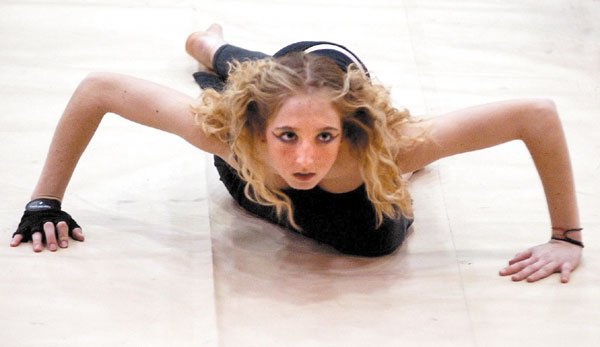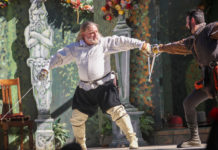Students who participate in winter color guard are motivated,
athletic and artistic, and during their seasons, they strive for
perfection
It is a living, moving, beautiful work of art. A rifle flies upwards, spinning, spinning, spinning, then lands squarely in the hands of the color guard member who had launched it in the air. Music blares through speakers in the gym, accompanied by the faint sound of a dull pat of feet moving across the basketball court.
A small sea of flags takes flight, arcing toward the ceiling then slashing down at an angle, each brightly colored piece of fabric moving in sync with the flags around it. Color guard performers move past each other, twirling and swirling 5 1/2-foot poles, but never smacking into or tripping over each other. These are the winter shows of South Valley high school color guards.
During the first semester of school, color guards are associated with and perform with the marching bands. During the second semester, color guards – often called winter guards during this semester – perform their own shows to music selected by their advisors.
The routines often feature backdrops or specialized props, and the choreography is original to the teams. The guards perform all over the region, some traveling as far as Long Beach to compete against other teams in their divisions. Judges evaluate the teams based on how well the guards spin their equipment in unison, how difficult the moves are, how well the routines match the music and creativity. Teams can lose points for things such as stepping out of bounds or for using more than their allotted time.
Judges make comments during the performance on audio tapes, which are eventually sent to the teams so they can learn from the critique.
Gilroy
Gilroy High School has the only color guard in the South Valley using sabers, which resemble large swords, in their show in addition to rifles and flags. The team performs to the song “Express Yourself,” a funky, upbeat song from the “Mr. & Mrs. Smith” movie soundtrack. Guard members wear bright blue, and the backdrops and flags they use are also bright, primary colors.
“At first I thought it was going to be really easy to do when I joined (the team),” said Michael Aguilar, a 15-year-old sophomore. “But to put the counts together, to move across the floor and spin, it’s really hard. Eventually it all just falls together, but it takes a lot of practice.”
It’s hard for some male members of color guard, a stereotypically female sport, to deal with stigmatisms that come with being on the team, Aguilar said.
“Some people consider it a ‘gay’ sport, but I don’t care,” he explained. “It’s so much fun, and I love doing it. I love going out there and performing with the greatest group of people I’ve ever met.”
Part of winter guard’s appeal is its uniqueness, Aguilar said. He was attracted to the sport because many people play basketball or football, but not many do color guard.
Morgan Hill
Live Oak High School is performing to music by the band Deep Forest, which sounds like a mixture of Indian, Middle Eastern and French songs laid over mellow electronic tracks. The floor covering they dance on features fall-colored leaves, and their flags compliment the theme, as do their maroon, Indian-inspired costumes.
Audra Sebastian said she chose to do winter guard rather than an activity like cheerleading partly because Live Oak cheerleaders don’t compete – and she loves to compete.
“Also, (color guard) combines dance and equipment and is so intricate,” said Sebastian, a 16-year-old junior. “People don’t really understand what we do, and we’re not as noticed or as appreciated as cheerleaders, but we’re not just flag twirlers.”
Learning how to spin flags and rifles can be hard at first, but most team members take a “no pain, no gain” attitude, said Morgan Coleman, a 14-year-old freshman.
“Yeah, you hit yourself– you hit yourself a lot at first,” she explained. “But you push through it and know that the more you try, the closer you get to doing it right.”
Hollister
San Benito High School varsity winter guard achieves an elegant simplicity with a pale rose-colored floor covering and their black costumes as they perform to Sting’s song “Desert Rose.”
Mario Cisneros, a 17-year-old junior on the guard, said he originally joined after hearing about color guard in announcements at school. He wanted to learn how to dance.
“When I got into it, I made a lot of friends and I met a lot of girls, so it was cool,” he said, laughing. “I found out it’s not just about spinning flags and rifles, it’s about jazz, hip-hop and a lot of dancing.”
Rifles are Cisneros’ favorite part of winter guard, and he has a rifle solo for the first time this year.
Performing is 17-year-old Alicia Johnson’s favorite part of guard because she said she likes the intensity. She joined the winter guard because her best friend got her involved in it. Johnson performs with the junior varsity winter guard to Sting’s song “Book of My Life.”
“Once the music gets going, you hear the words to the music, and you think of what they mean to you, and you feel the flow of what he’s trying to say, and it’s awesome,” Cisneros said.
Anatomy of a Toss
Color guard members regularly have 5 1/2-foot aluminum poles spinning above their heads and around their bodies. Here’s how to perform the perfect “single-and-a-half toss” with a flag:
1. Place your right hand palm-up where the bottom of the flag and the pole meet.
2. Place your left hand palm-down a third of the way down the pole. Your two hands should be dividing the pole into almost perfect thirds.
3. Your right hand should be located near your right hip and your left hand located near your left shoulder, so the flag is at a diagonal to your body, flag end down.
4. Keeping your elbows out, push down on the pole with your left hand while rotating your right hand and guiding the flag upwards.
5. Release the flag.
6. Catch the flag with your hands opposite to how they were at the beginning of the toss. The flag should be at a diagonal to your body and the flag should be facing up, near your left shoulder.
See for Yourself:
Winter Guard International regional competition will feature Live Oak and San Benito high schools and professional color guards. Color guards from all over the western region will compete against each other for trophies and glory.
Preliminaries are from 9am-9pm March 25 at the Leavey Center at Santa Clara University. Finals are from 9am-4:30pm March 26 at the Leavey Center at Santa Clara University.
The Leavey Center is located at 500 El Camino Real in Santa Clara. Tickets are $15 for preliminaries, $18 for finals and $28 for both days. Info: (937) 434-7100 or www.wgi.org













